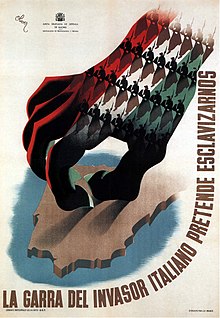Italian military intervention in Spain
| Italian military intervention in Spain | |
|---|---|
| Part of the Spanish Civil War | |
 Republican poster, reading "The claw of the Italian invader intends to enslave us." | |
| Location | |
| Objective | Assist Nationalist forces |
| Date | 1936–39 |
| Executed by | |
| Outcome | Italian victory
|
The Italian military intervention in Spain took place during the Spanish Civil War in order to support the nationalist cause against the Second Spanish Republic. As the conquest of Ethiopia in the Second Italo-Ethiopian War made Italy confident in its power, Benito Mussolini joined the war to expand the Fascist sphere of influence in the Mediterranean.[1] Italy supplied machine guns, artillery, aircraft, tankettes, the Aviazione Legionaria, and the Corpo Truppe Volontarie (CTV) to the Nationalist cause.[2] The Royal Italian Navy (Italian: Regia Marina) played a substantial role in the conflict and Italian warships took part in breaking the Republican navy's blockade of Nationalist-held Spanish Morocco and took part in naval bombardment of Republican-held Málaga, Valencia, and Barcelona.
Italian planes carried out most of the large-scale bombing operations, striking the cities of Barcelona, Alicante, Granollers, and Valencia, as well as the railway stations of Sant Vicenç de Calders and Xàtiva. With a total of 728 raids on Spanish Mediterranean cities, the Aviazione Legionaria dropped 16,558 bombs and inflicted numerous casualties.[3] By the end of the conflict the Aviazione Legionaria had logged a total of 135,265 hours' flying time on 5,318 operations, dropping 11,524 tons of bombs and destroying 943 enemy air units and 224 ships.[4]
In total, Italy provided the Nationalists with 660 planes, 150 tanks, 800 artillery pieces, 10,000 machine guns, and 240,000 rifles. The Italian CTV would, at its peak, supply the Nationalists with 70,000 men and played a decisive role in the conflict; according to the historian Rodrigo Javier "the Italians were crucial to the success of the Rebel army in occupying Málaga, Bermeo, Santander, in breaking through and stabilizing the Aragon front, in the occupation of Barcelona and Girona and in concluding the Levantine campaign".[5][6][2]
Organization
[edit]- Aviazione Legionaria (Air force)
- Corpo Truppe Volontarie (Army)
- Italian Naval Mission (Navy)
- Submariners Legion
See also
[edit]References
[edit]- ^ Beevor (2006). pp. 135–6.
- ^ a b Beevor (2006). p. 199.
- ^ Heiberg, Morte (2004). Emperadores del Mediterráneo: Franco, Mussolini y la guerra civil española. Barcelona: Crítica. ISBN 8484324702; p. 133
- ^ Balfour, Sebastian; Preston, Paul (2009). Spain and the great powers in the twentieth century. London, UK; New York, USA: Routledge. p. 172. ISBN 978-0-415-18078-8.
- ^ Rodrigo, Javier (2019). "A fascist warfare? Italian fascism and war experience in the Spanish Civil War (1936–39)". War in History. 26 (1): 86–104. doi:10.1177/0968344517696526. S2CID 159711547.
- ^ Thomas (2001). pp. 938–939.
